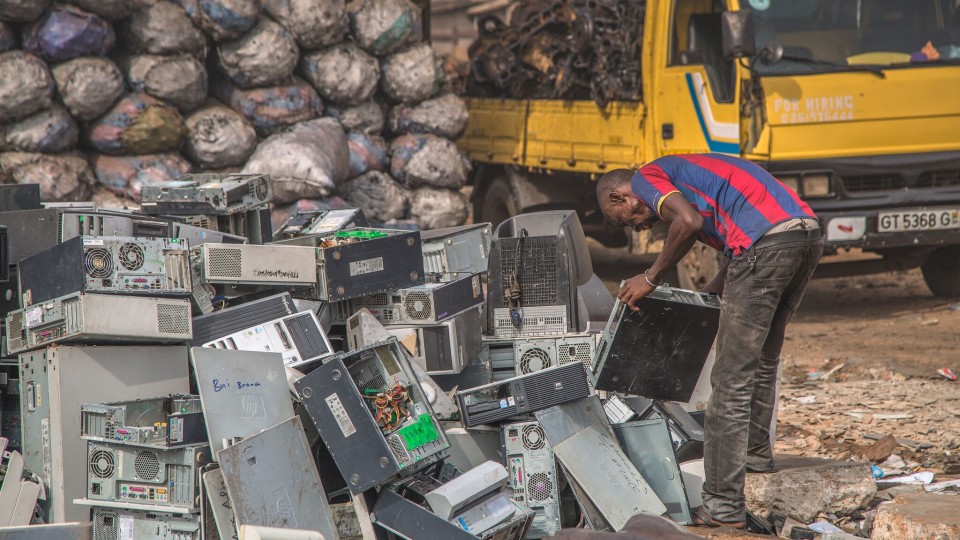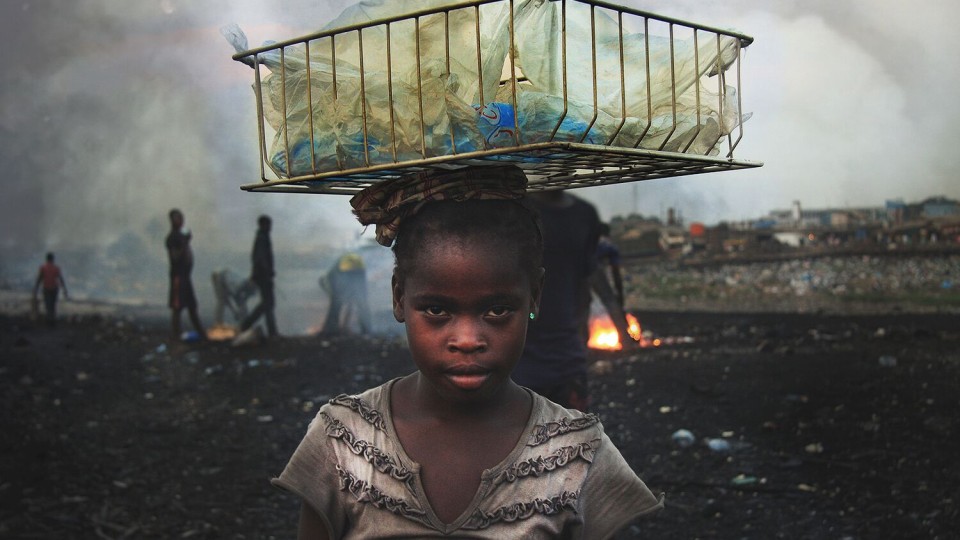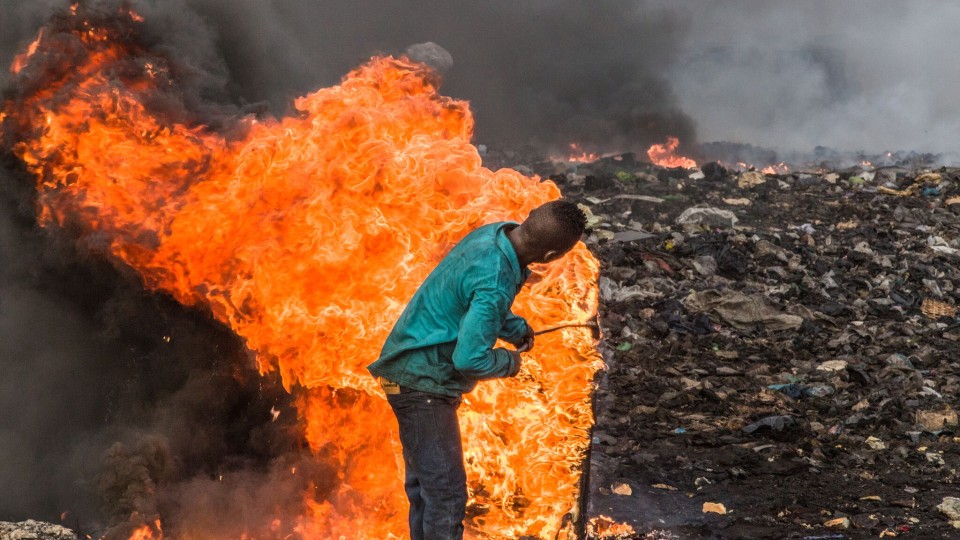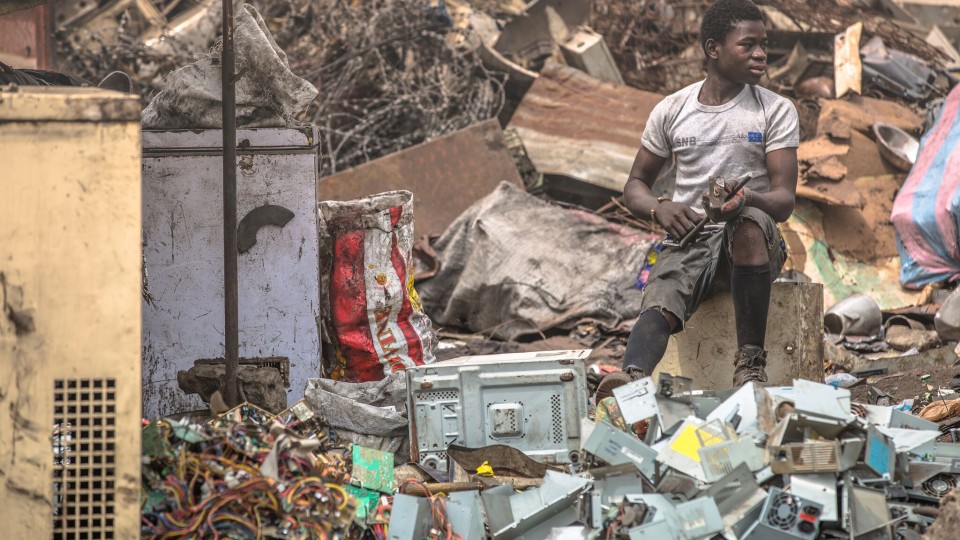One of the most poisonous scrapyards on the planet can be found in the middle of Ghana’s capital. Electronic scrap is brought
here by the container-load, and the people who recycle it earn a pitiful living, while the air is polluted, the water is poisoned,
and the city has been brought to the verge of ecological collapse. In the middle of the garbage, filth and chaos of Agbogbloshie,
Christian Krönes and Florian Weigensamer expose a microcosm and the system which governs it in WELCOME TO SODOM, sending an alarming signal to Western consumers.
Your first shot of Agbogbloshie reveals a scrapyard with herds of sheep and goats grazing on it as if it were a meadow. Nature
collides with a particularly repulsive facet of civilisation as the toxic scrap of consumer mania is passed on to people who
possess nothing, with utter indifference and no concern for their environment. Was it this collision which gave the location
the cinematographic force which prompted you to make it the subject of a film?
FLORIAN WEIGENSAMER: To some extent it was definitely the visually striking contrasts of this gigantic scrapyard, but it was also the history
of the place. If the stories about it are to be believed, not so very long ago it must have been a beautiful lagoon. It has
descended into its present condition in just a few years. People say you shouldn't stay there for more than two hours, because
it's one of the most poisonous places in the world. We spent almost 2 months there; we wanted to give a face and voice to
each of the people living and working there, at the lowest and filthiest end of the value-added chain in our technological
age.
CHRISTIAN KRÖNES: In a way, Ghana can be seen as symbolic of dystopian society. There are a few super-rich individuals whose lives are completely
sealed off from the majority of people: they have to survive on a dollar or two a day. At the same time, it's a comparatively
wealthy country which is sometimes called the Switzerland of Africa. That’s why the capital, Accra, exerts a magical attraction
on people from the poorer north and the economically weaker neighbouring countries, who move there in the hope of forging
new lives for themselves. What everybody in Ghana has in common is the impending ecological collapse of the country. Agbogbloshie
is only one of the hot spots, though it's a particularly dramatic one. Over 6000 people live on the electronic scrapyard in
the centre of Accra. The river that flows through the site is completely dead: the water is extremely toxic
but it is used
to irrigate the surrounding fields. Just a kilometre further on the river flows into the Atlantic, contaminating the fish
stocks there.
It is clearly far from a comfortable and easy place to perform research. How would you describe your first impressions of
it?
FLORIAN WEIGENSAMER: When you set foot in Agbogbloshie it's an absolutely devastating experience. The noise, the working conditions, the filth;
you constantly have a metallic taste in your mouth, and you simply can't get your bearings in that vast space. It all began
in the early years of this century when secondhand electronic appliances were exported to Ghana as part of a development aid
project. Inventive business people quickly realised exporting scrap like that could be a good business on the side. According
to the Basel Convention, exporting electronic scrap from the EU is forbidden, so the appliances are officially registered
as secondhand. The containers arrive full of monitors and computers, and nobody can possibly check if any of it is actually
usable. It's a very cheap way to get rid of the stuff. Disposing of it in Europe in line with regulations would be many times
more expensive.
How long did it take you to form a picture of the way this micro-society actually works?
FLORIAN WEIGENSAMER: At first the place strikes you as absolutely chaotic, and it took me a long time to understand that everything is in fact
organised there. Every part of the land belongs to someone, and everyone has a well-defined job. What the people have developed
in that scrapyard is a fascinating social structure.
CHRISTIAN KRÖNES: If you take a closer look and focus on the organisation, the first apocalyptic image fades into the background. You discover
that for the people there, this place is full of perspective: it's a place to celebrate the joy of life and incredible creativity.
In the apparent chaos of the scrapyard we discovered a smooth-running organisation, an orderly system, and we met people who
practice recycling in the best sense of the word. The most important raw materials that can be recovered from the electronic
scrap are iron, aluminium, and above all copper, which is released when the cable installation is melted off. One way or another,
these raw materials are returned to the economic cycle of the international market.
At the very beginning were you confronted by the fundamental question of how to approach a surreal place in documentary style?
FLORIAN WEIGENSAMER: It would be impossible to comprehend Agbogbloshie in all its dimensions, either in pictures or words. We wanted to convey
to the audience the same feelings we had when we first arrived there, when we walked through the place: the sensation of discovering,
looking around and not understanding.
You've chosen a symbolic, almost fictitious introduction. Archaic-looking close shots of the skin of a chameleon, with a voice
off reciting a text which has a mythological tone. Where does the symbolism of the chameleon come from?
CHRISTIAN KRÖNES: The chameleon isn't so fictitious at all. A few decades ago the creatures were endemic here. We also chose this introduction
because the place doesn't come across as real. It seems to be situated outside our world, beyond our imagination. On the West
Coast of Africa there is a lot of symbolism associated with the chameleon, with many creation myths and stories surrounding
it.
FLORIAN WEIGENSAMER: These days the chameleon is almost extinct in Ghana. And the mythical stories which surrounded the animals for hundreds of
years are also slowly being forgotten, because of the cultural and technological exports from the West. Just as the natural
paradise is being destroyed, so is the mythological one. It's sinking under a mountain of monitors and dismantled computers.
So we thought the story finally had to be told, especially to people here in Europe.
In terms of camerawork, you've chosen to use very long shots of certain activities, and also to make the physicality of the
work extremely tangible; I’m thinking of the child collecting metal with a magnet, and the burning of the balls of cables.
CHRISTIAN KRÖNES: Christian Kermer’s subtle camerawork is what makes it possible for the audience to grasp this apocalyptic side. In order
to understand this non-place, you have to look deeper. That can't be achieved by using images which are shocking or – even
worse – which bestow aesthetic appeal on poverty. We wanted to submerge the audience in this unreal setting and help people
feel what living and working in such a relentless place really means.
The burning of cables, the flames and the swathes of smoke – it all produces extremely spectacular footage. Even if you want
to distance yourself from superficial TV documentaries, the spectacular must still exert a temptation. How can that be resisted?
FLORIAN WEIGENSAMER: That was definitely the most difficult balancing act: on the one hand, to show reality, but at the same time never to become
speculative. The impressions you get there are so visually powerful that the images are inevitably drastic. Remaining at the
same level as the people in our narrative wasn’t easy by any means. By using long shots and wide shots we attempted to dispel
the dramatic aspect, to move away from pointing a finger and to get closer to a process of discovery that each member of the
audience experiences individually. Christian Kermer performed this balancing act with the camerawork, and later with the editing,
in a very sensitive way.
You made the fundamental choice not to have anyone speaking on camera; there are only voices off. How did the texts come about,
especially those spoken by the younger protagonists?
FLORIAN WEIGENSAMER: It wouldn't have been possible to have those statements made spontaneously on camera. After all, when you're faced with certain
questions you need time to think about them. We gave our protagonists issues to consider and recorded their answers the following
day. Recording sound there is quite a job anyway. The constant noise is hard to imagine.
CHRISTIAN KRÖNES: We always chose Fridays and Sundays, which are the religious holidays of the two largest groups of people there; that meant
there wasn't so much going on. We would head away from the dump to a henhouse, a tin shed, and we moved the hens out temporarily
so we could do the sound recording.
What were your feelings when you left Agbogbloshie?
CHRISTIAN KRÖNES: When you spend so much time there, and you develop close relationships with people, it's really upsetting to leave again.
While we were there we were certainly able to help in a few emergency situations, and to provide a bit of support. You leave
the country knowing that the people there have no choice; they have to stay, and you can't give them any sustainable assistance.
The most difficult moment emotionally was definitely when one woman asked us to take her daughter with us. How desperate would
a mother have to be, to entrust her child to a stranger? She couldn't really understand why it wasn’t possible. Being unable
to help her was a very oppressive feeling.
Has WELCOME TO SODOM been your biggest project in terms of international perspective?
CHRISTIAN KRÖNES: We're living in a globalised world, and we can't isolate ourselves. But the gap between the First and the Third World is
getting bigger all the time. Political forces are promoting activities in those countries to give the people new perspectives
– purely so they will not set off towards Europe – and then development aid is reduced. And it's becoming harder and harder
to make difficult films at international locations. With few exceptions, the focus for subsidies and film financing is on
a very local sector. Feel-good cinema and tourist aspects are in the foreground. It's hard to make critical documentary films.
But I think as filmmakers it is our task to confront the audience with the truth, even when it's uncomfortable.
Interview: Karin Schiefer
March 2018
Translation: Charles Osborne






